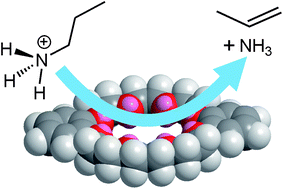Catalytic cycles can be investigated in detail in the gas phase in a step-by-step manner by tandem mass spectrometric experiments that allow for the mass-selection of each of the intermediates prior to the subsequent step. In the present article, we describe large crown ethers (dibenzo-24-crown-8 to dibenzo-30-crown-10) to mediate the E2-elimination of propene from crown ether-propylammonium complexes giving rise to NH4+/crown ether complexes. A back exchange of the ammonia against propyl amine completes the catalytic cycle. To the best of our knowledge, this reaction cycle represents the first example of organocatalysis in the gas-phase. In addition, the larger crown ethers significantly accelerate the H/D-exchange reaction of the five NH hydrogen atoms in singly protonated ethylenediamine as compared to the analogous smaller crown ether complexes. This effect, which is not observed for the propylammonium complexes, can be rationalized by a favorable pre-organization of the protonated ethylenediamine ion within the cavity of the crown ether through hydrogen bonding to both the ammonium and the amine groups. Within this complex, the H/D-exchange can proceed through an efficient “relay” mechanism. A comparison of the H/D-exchange behavior of ammonium complexes with differently sized crown ethers reveals a distinct reactivity pattern that strongly depends on the crown ether size. While 18-crown-6 acts as a non-covalent protective group suppressing the H/D-exchange almost completely, smaller and larger crown ethers exhibit higher exchange rates.

You have access to this article
 Please wait while we load your content...
Something went wrong. Try again?
Please wait while we load your content...
Something went wrong. Try again?


 Please wait while we load your content...
Please wait while we load your content...